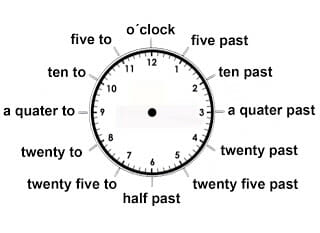Ahora te enseñaremos a como decir correctamente la hora en inglés. Tengan en cuenta que en este idioma primero se dicen los minutos y después las horas, al contrario del español.
Primero de dice It is o It's, que es igual a decir: Son las...
- si se trata de la "hora en punto": It's + la hora + o´clock
- si son cuartos de hora se dice: " a quarter"
- para decir hora y media: It´s + half past + la hora
- para decir una hora mas exacta primero se dicen los minutos, seguido de "menos" o "y" y se terminara con la hora conveniente:
It´s + minutos + past / to + hora
PARA PREGUNTAR:
Se usan las expresiones:
What is the time? / What time is it?
https://www.youtube.com/watch?feature=player_embedded&v=xzjF7m-kB8E (este video ayudara a darte mas información)





